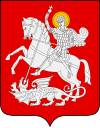Duchy of Kldekari
| Duchy of Kldekari კლდეკარის საერისთავო | |||||
| Principality of the Kingdom of Georgia | |||||
| |||||
-1.jpg) | |||||
| Capital | Kldekari | ||||
| Historical era | Middle Ages | ||||
| • | Established | 876 | |||
| • | Disestablished | ca. 1103 | |||
| Today part of | |||||
Kldekari (Georgian: კლდეკარი) was a duchy (saeristavo) within the kingdom of Georgia from 876-1103. Ruled by a powerful dynasty of Liparitids-Baghuashi, the duchy existed in the south-western parts of modern Kvemo Kartli province, and, despite its small size, created problems for the Bagrationi kings as they sought to bring all Georgian vassals and principalities into a unified state.
History
The duchy was established in 876 by Liparit I of the Baghuashi, who had been expelled by the Abkhazian kings from his fiefdom of Argveti in upper Imereti.[1] In their new fiefdom, the Liparitids accepted the suzerainty of David I Kuropalates, a Georgian Bagratid prince of Iberia based in Tao-Klarjeti, and built a stronghold called Kldekari (Georgian: კლდე კარნი; lit. the "rocky gates") on a strategic mountain of the Trialeti Range to control the roads cut through the cliff connecting the regions of Eastern Georgia with the southern neighboring countries and the Byzantine Empire. This area lay in the possessions of David’s kinsman Guaram Mampali, and the move eventually led to a split among the Bagratids which concluded with the murder of David by his nephew (son of Guaram Mampali) Nasra in 881. In a civil war that ensued, Liparit supported David’s heir, Adarnase I, who was victorious and crowned, with the Armenian support, as King of the Georgians in 888. Thus, Liparit and his heirs secured a hereditary dukedom of Trialeti and Kldekari. They quickly rose in prominence, gaining more possessions and prestige and when, in the early 11th century, the Bagratid dynasty established the unified all-Georgian monarchy, the Liparitids were among its most powerful vassals and rivals.
In the mid-eleventh century, the Liparitid house reached the apogee of their might and remained, for a century, leaders of the feudality in its struggle against the growing power of the kings of Georgia. In 1047, one of the most illustrious representatives of the family, Liparit IV even succeeded in temporarily driving King Bagrat IV into the Byzantine territory. The kings of Georgia had to concede more possessions and titles to the family in order to pacify a series of the Liparitid rebellions. Liparit IV became a regent for the young Georgian king Bagrat IV in the early 1030s. Subsequently, relations between the two men deteriorated and flared into an armed conflict. With the military support from the Byzantine Empire, Liparit defeated Bagrat at the Battle of Sasireti (1042) and became a virtual ruler of Georgia, but eventually he was forced out by his own subjects in 1059. His son and heir, John, was allowed by the Georgian crown to succeed Liparit IV as a duke. In 1074, John revolted against King George II of Georgia, and attempted to get Seljuk support. However, a Seljuk invasion force temporarily occupied the duchy and captured the ducal family.
David IV, a new and perhaps the most successful king of Georgia, forced the Liparitid-Baghuashi into submission in 1093, and checked their subsequent attempts to revolt. In 1103, he took advantage of the death of the last Kldekarian duke Rati III and abolished the duchy incorporating the area directly into a royal domain.
Rulers
| Prince | Reign | Notes |
|---|---|---|
| 1. Liparit I | (876–?) | |
| 2. Liparit II | (940–960) | |
| 3. Rati I | 960–988 | |
| 4. Liparit III | 988–1005 | |
| 5. Rati II | 1005–1021 | |
| 5. Liparit IV | 1021–1059 | magistros |
| 6. John (Ioane) | 1059–1080 | |
| 7. Liparit V | 1080–1095 | |
| 8. Rati III | 1095–1102 | |
See also
External links
- (in Georgian) "Duchy (Saeristavo) of Kldekari."
References
- ↑ (in Russian) Летопись Картли / Пер., введ. и примеч. Г. Цулаиа; [Ред. тома Ш. Бадридзе], Тб.: Мецниереба, 1982.
